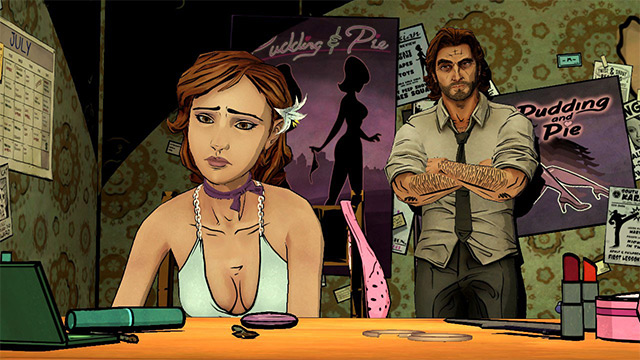Last updated on March 29, 2014
Talking about female nipples may be the fastest path away from meaningful conversation about Christian discipleship and video games. But since you have obviously resisted the temptation to dismiss this post, maybe we can process the use of topless women in The Wolf Among Us: Episode 2 – Smoke and Mirrors?
In Smoke and Mirrors, Bigby confronts a strip club owner while he’s offering a “critique.” Herein lies the concern: is it pornographic sexism?
The real the question for any media with nude forms is “what is this trying to do?” Is the goal to arouse the male gaze? If so, you can probably toss it wherever smutty garbage goes. If it can lead to character development (such as a life-drawing class), maybe it has value? It might be a weird idea for many in religious circles to consider that confronting people with nude forms can lead to character development. But really think about it. When you unexpectedly see a naked person, doesn’t your immediate response show what kind of person you are?
For many who have “made a covenant with their eyes“, it’s reasonable to exit the game and toss it your Recycle Bin. But since this game is an interactive medium about character development, maybe the best option is to try to look away and seek for a way to clothe the character? Maybe rush the dialog to a point where the club owner can’t further exploit this young lady? If for nothing else, you can think about what kind of person you are if you just try to place Bigby at the right angle so you can see the show?
I believe a story’s value lies in its themes. And after two episodes of Wolf Among Us (and reading a volume of Fables), it seems that the theme is about compromised people living in exile. As that setting and theme gets established, my goal becomes to empower and humanize these exiles and refugees. So for me, it seemed fitting to look past the stripper’s dance and seek for ways to affirm her value as a person. The game let me do this after the club-owner conversation (to a small degree) and as such, made the whole experience much more meaningful to me than if I just turned it off.
In his opinion piece titled, It’s time to leave the brothels and strip clubs behind when real victims fuel your narrative, Ben Kuchera says the strip club setting is cheap shorthand for “people who hang out here are bad.” His core thesis wraps up by saying, “…games tend to be uninterested in telling the human aspect of this story. These characters exist only to die or be beaten in order to flesh out male villains.”
Kuchera goes on to say, “Rarely are the women involved in these scenes seen as three-dimensional characters, however. They exist to show their bodies, excite the players, get beaten to prove that other characters or bad, or just to die so the story can move forward.”
This may very well be the case in games like Grand Theft Auto 5 and Hitman Absolution. But where Telltale’s Wolf Among Us seems to excel is in the small-but-significant way it gives the player the opportunity to stop the strip show and then empathize with the plight of the young woman in the situation. Simply by giving this woman a voice and fleshed-out dialog tree, she doesn’t become a tool, but a meaningful character.
I would assert that how you play a game is a reflection of your integrity. So when a straight hormone-driven male is confronted with a nude female form in Smoke and Mirrors or any game, a character issue goes on full display: does he gawk? Does he avert his eyes? And if he’s holding the controller, does he choose to play in a way that is most respectful of women?
Read Josh’s article about Episode 1 too!

